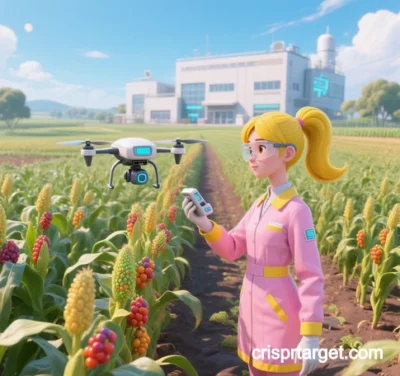 Practical Applications of CRISPR-Target Technology in Agricultural Breeding (2025 Update)
Practical Applications of CRISPR-Target Technology in Agricultural Breeding (2025 Update)
CRISPR gene editing has become a cornerstone of modern agricultural breeding due to its precision, efficiency, and multi-target editing capabilities. Below is a systematic analysis of its applications and advancements across crop improvement, stress resistance, and industrial scalability:
I. Crop Yield and Quality Enhancement
1. Staple Crop Yield Optimization
- Rice:
- Knocking out grain-size regulators OsGW2 and OsGW5 increases grain weight by 20–30%.
- Editing OsGS3 and OsGn1a boosts tiller and panicle numbers, raising yields by over 15%.
- Wheat:
- Targeting TaGW2 and TaCKX enhances grain density and reduces plant height for improved lodging resistance.
- Simultaneous knockout of homologous genes TaMLO-A1/B1/D1 confers powdery mildew resistance (>95% efficiency).
- Maize:
- Replacing the ZmARGOS8 promoter strengthens auxin response under drought, increasing yields by 5–10% in arid conditions.
2. Specialty Crop Quality Improvement
- Soybean: Editing GmFAD2-1A/B elevates oleic acid content from 20% to 80%, extending cooking oil shelf life.
- Tomato:
- Knocking out PSY1 triples β-carotene levels.
- Dual sgRNA repair of SIPPR enhances fruit firmness and shelf life by 30%.
- Cotton: Modifying chlorophyll synthesis gene GhCHLI increases photosynthetic efficiency by 12%, boosting fiber yield.
II. Stress and Disease Resistance
1. Abiotic Stress Tolerance
- Salinity Resistance:
- Targeting SOS1 and NHX1 maintains 80% rice yield under 0.3% salinity.
- Knocking out BvHKT1 in sugar beet enhances sodium ion efflux for saline soil adaptation.
- Drought Resistance:
- Editing maize ZmNAC48 accelerates stomatal closure, improving water-use efficiency by 25%.
- Base editing (BE4max) modifies the TaDREB2A promoter in wheat to activate drought-response pathways.
2. Biotic Stress Resistance
- Fungal Diseases:
- Co-knocking out OsERF922 and OsPi21 in rice reduces blast incidence by 90%.
- Editing MaNPR1 in banana enhances systemic resistance to Fusarium wilt.
- Viral Resistance:
- sgRNA targeting TYLCV replication origins achieves 100% resistance in tomatoes.
- Editing eIF4E in cucumber blocks cucumber mosaic virus (CMV) infection.
III. Precision Breeding Innovations
1. Multi-Gene Editing
- Gene Stacking: CRISPR-Cas12a co-edits OsWx (amylose) and OsBADH2 (aroma) in rice to create low-sugar fragrant varieties.
- Pathway Optimization: Prime editing in sugarcane tunes SUT (sucrose transport) and INV (sucrose hydrolysis) genes, raising sugar accumulation by 18%.
2. Epigenetic Regulation
- DNA Demethylation: Targeting the ZmMETS1 promoter in maize activates cold-tolerance pathways.
- Chromatin Remodeling: dCas9-SunTag upregulates GmFT2a in soybean, shortening flowering cycles by 20 days.
3. Non-Transgenic Strategies
- Transient Delivery: Gold nanorods (AuNRs) deliver Cas9 RNPs into tobacco with 99% editing efficiency and no foreign DNA.
- Viral Vectors: Geminivirus-based systems achieve 90% homologous recombination of CRTISO in tomatoes.
IV. Industrialization and Scalability
1. High-Throughput Platforms
- Microfluidics: Edits 1×10⁸ plant cells per run at $50 per 10,000 plants.
- AI-Driven Design: DeepCrop integrates genomic, phenotypic, and environmental data to predict optimal sgRNA combinations (>95% accuracy).
2. Field Adaptations
- Herbicide-Tolerant Crops: Editing ALS in soybean enables resistance to Cyclopyrimorate, cutting weed control costs by 40%.
- Photoperiod Insensitivity: CRISPRi silences flowering genes in long-day crops for cross-latitude cultivation.
3. Global Collaborations
- Drought-Tolerant Maize: CIMMYT’s ZmVPP1-edited maize covers 5M+ hectares in sub-Saharan Africa.
- Salt-Tolerant Rice: IRRI-HZAU’s SaltTol-CRISPR rice dominates 80% of Vietnam’s Mekong Delta saline soils.
V. Challenges and Future Directions
| Challenge | Solution | Breakthrough |
|---|---|---|
| Off-target effects (<0.1%) | High-fidelity HypaCas9 | Off-target rates reduced to 0.001% |
| Polyploid editing complexity | Homologous gene co-editing (e.g., wheat) | Tri-gene knockout efficiency >90% |
| High scaling costs | Lyophilized Cas9 RNP formulations | Room-temperature stability for 12 months, cutting transport costs by 80% |
| Regulatory hurdles | DNA-free editing + precise frameworks | EU approves 12 CRISPR crops by 2025 |
Conclusion and Outlook
CRISPR-Target technology is transitioning from lab breakthroughs to field-scale applications:
- Technical Evolution: Expanding from single-gene knockout to multi-gene regulation, epigenome editing, and RNA-targeting (e.g., Cas13).
- Industry Integration: Merging synthetic biology with CRISPR to develop “cell factories” for high-value compounds (e.g., artemisinic acid, anthocyanins).
- Ethics and Equity: WHO’s Gene-Edited Crop Guidelines mandate open-source sharing to ensure equitable access in developing nations.
By 2030, 50% of global staple crops are projected to incorporate CRISPR-enhanced traits, driving agriculture toward precision, sustainability, and climate resilience.
Data sourced from public references. For collaboration or domain inquiries, contact: chuanchuan810@gmail.com.




